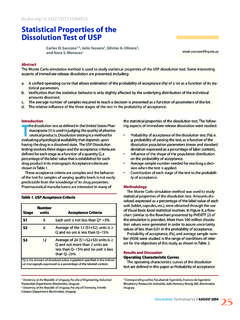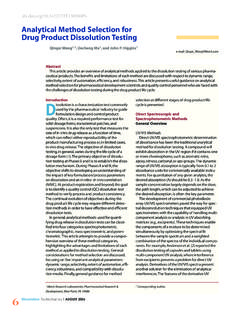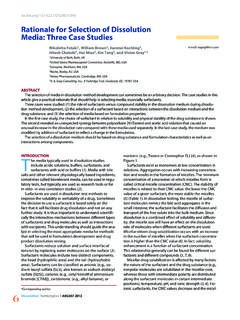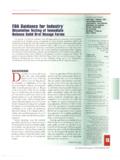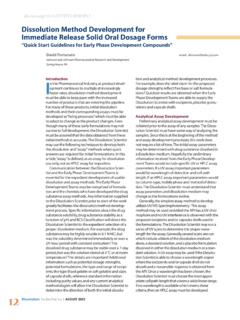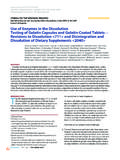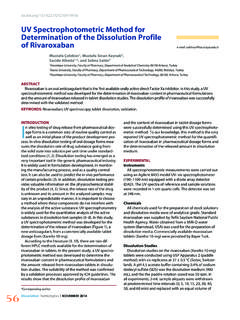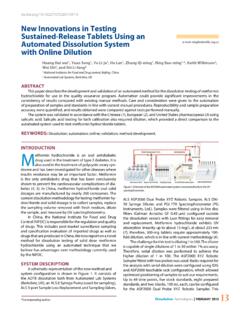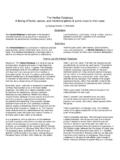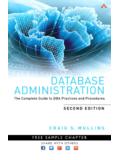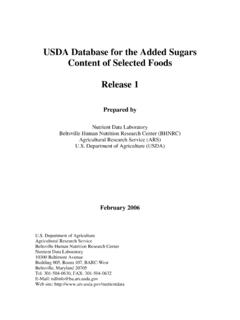Transcription of A Brief Review of the FDA Dissolution Methods …
1 A Brief Review of the FDA Dissolution Methods database I. E. Shohin1, D. Yu. Grebenkin2,*, E. A. Malashenko3, Ya. M. Stanishevskii2, and G. V. Ramenskaya3 e-mail: 1 Center of Pharmaceutical Analytics Ltd, 20, Nauchniy Proezd, Moscow 117246, Russia 2 Institute of Biochemical Technology and Nanotechnology Peoples' Friendship University of Russia, 10-2, Miklukho-Maklaya St., Moscow 117198, Russia 3 Sechenov First Moscow State Medical University, 8, Trubetskaya st., Moscow 119991, Russia ABSTRACT. The FDA Dissolution database was reviewed using the following criteria: dosage forms, apparatus, rotation/pulsation speed, Dissolution media, sampling time points, and trends for special dosage forms. In July 2015, there were 1084 drug products in the database , more than 50% thereof in tablet form. The paddle (Apparatus 2) is the most common apparatus in the database and is recommended for 488 products (45%).
2 Rotation speeds listed in the database are 35 200 rpm for Apparatus 1 and 25 200 rpm for Apparatus 2. Deaerated or degassed water is recommended for 114 Methods . The pH. values for the most commonly cited Dissolution media are in the range of 1 ; however, several Dissolution Methods have pH values that are out of physiological range (pH 12 for celecoxib capsules, pH for glyburide tablets, pH for Rabeprazole Sodium Tablets, pH for Glimepiride Tablets). KEYWORDS: Dissolution ; FDA; Dissolution Methods database ; Dissolution apparatus. INTRODUCTION. T. Dosage Forms he Dissolution profile test is one of the most useful The most common dosage forms in the FDA database Methods used in different stages of the drug are tablets and capsules (Figure 1). More than 65% of the product lifecycle: pharmaceutical development, products presented are in tablet dosage form.
3 There are stability studies, interchangeability evaluation, routine delayed-release tablets, coated tablets, enteric-coated quality control, and scale-up and post-approval changes. tablets, orally disintegrating tablets (ODT), and chewing This test is suitable for a wide range of dosage forms tablets. About 26% of the products are capsules, among such as tablets and capsules, transdermals, suspensions which are the soft capsules, capsules with liquid contents, for internal use and for injection, suppositories, gums, and capsules with delayed release. chewing tablets, powders, vaginal inserts, implants, and others. The Food and Drug Administration Dissolution database (1) is open access and is updated on a quarterly basis. There were 1084 drug products in the database at the time of search (July 2015). The database provides information on drug products in terms of International Nonproprietary Name (INN), dosage form, USP apparatus type, speed (rpm), Dissolution medium, volume, sampling time points, and date of latest update.
4 The structure of the FDA Dissolution database reported was reviewed in more detail (2). The database is one of the most accessible, suitable, full, and informative resources on Dissolution . Figure 1. Dosage forms in the FDA database . The aim of this paper was to make a Brief Review of the The FDA database contains Dissolution Methods for database in terms of dosage form, apparatus, rotation/. suspensions for internal and external use, injectable pulsation speed, and Dissolution media. *Corresponding author. 6 AUGUST 2016. suspensions, and ophthalmic and otic suspensions. Betamethasone Sodium Phosphate Injectable However, Methods for such dosage forms are rather rare Suspension, Medroxyprogesterone Acetate Injectable (about of the database content). About of the Suspension, and Methylprednisolone Acetate Injectable database describes the Dissolution of transdermal dosage Suspension.
5 Forms such as patches, films, and others. It also contains Apparatus 5 (paddle-over-disk) is used for Dissolution of Methods for suppositories, powders, pellets, vaginal topical and transdermal dosage forms (sublingual film rings, vaginal inserts, implants, gels, and chewing gum. of buprenorphine HCl/naloxone HCl, topical patch of Apparatus diclofenac epolamine, transdermal film of estradiol, etc.). All USP Dissolution apparatus (Apparatus 1 7) are listed Apparatus 6 (rotating cylinder) is recommended for in the Dissolution Methods database (3). The paddle seven Methods that should be carried out to ensure the (Apparatus 2) is the most common apparatus in the quality and performance of topical and transdermal drug database . It is recommended for approximately 70% products. of the Dissolution Methods (Figure 2) and is considered Apparatus 7 (reciprocating holder) is also used for the apparatus of choice for Dissolution profile testing transdermal delivery systems and a variety of dosage of immediate-release solid dosage forms.
6 For capsule forms ( , intravitreal implant of dexamethasone). dosage forms, sinkers may be used to prevent floating. They include spiral, pronged, and basket sinkers. The FDA database also refers to a number of However, cone formation is an important disadvantage of noncompendial apparatus, such as an incubator shaker the paddle. The disintegrated mass of a dosage form may used to dissolve a vaginal ring that is not described in settle at the bottom of the USP vessel where the agitation pharmacopoeias. There is also the chewing machine rate is minimal and form a cone of trapped drug particles, used for the analysis of nicotine chewing gum, which which leads to low Dissolution rates. is described by the European Pharmacopoeia. For 254. products (about 23%), the database does not state the test conditions but refers to relevant USP monographs.
7 There are no Methods mentioned for a number of drug products, and in those cases, the need of method development is noted. This is especially important for injectable dosage forms. Rotation Speed Rotation speed for Apparatus 2 (paddle) is 25 200 rpm as listed in the database . The lowest value (25 rpm) is typical Figure 2. Frequency of apparatus cited in the FDA database . for suspensions ( , Ampicillin for Oral Suspension and Meloxicam for Suspension). The most rapid rotation Approximately 17% of Dissolution Methods (122 speed for Apparatus 2 is listed in the Dissolution method Methods ) recommend using the basket (Apparatus 1). for Triptorelin Pamoate Injectable Suspension (200 rpm). This apparatus is commonly used for the Dissolution and Fentanyl Citrate Lozenges (175 rpm). A typical paddle of floating dosage forms. However, it has several agitation rate is 50 rpm.
8 Disadvantages: disintegrated particles can clog the basket The rpm values of Apparatus 1 (basket) vary in the range and small, disintegrated particles can fall out. of 35 200 rpm. The most common basket rotation speed Apparatus 3 (reciprocating cylinder) is recommended is 100 rpm (87 Methods of 122). The basket is rotated at for three extended-release tablets in the database : maximum speed (200 rpm) in the Dissolution method chlorpheniramine maleate, dexbrompheniramine for Quetiapine Fumarate Extended-Release Tablets. maleate, pseudoephedrine sulfate. Apparatus 3 can be The lowest speed for Apparatus 1 is 35 rpm, which is especially useful in cases where one or more pH/buffer used for Pitavastatin Calcium Tablets, while 40 rpm is changes are required in the Dissolution testing procedure recommended for Estradiol Vaginal Tablets. or when hydrodynamics can be directly influenced by The most common speed for Apparatus 5 and 6 (paddle- varying the dip rate.)
9 Over-disk and rotating cylinder, respectively) is 50. rpm. The flow speed of the Dissolution medium for the Apparatus 4 (flow-through cell) is recommended Apparatus 4 (flow-through cell) is in the range of 8 17 mL/. for only three Methods : Betamethasone Acetate / min. AUGUST 2016 7. Dissolution Media For water-insoluble or sparingly soluble drug products The FDA Dissolution database describes a large number (BCS Class II or IV), the use of a surfactant ( of different media, from water or simple buffer solutions of Methods ) such as sodium lauryl sulfate, Tweens with different pH values to solutions with added (polysorbate 20 and 80), lauryl dimethylamine oxide surfactants, organic solvents, and enzymes. (LDAO), Triton X, Brij 35 (polyoxyethylene lauryl ether), cetyl trimethyl ammonium bromide (CTAB), and others The simplest choice for a Dissolution medium is water.
10 (Figure 3) is recommended. The most commonly Deaerated or degassed water is recommended for used surfactant is sodium lauryl sulfate (SLS, SDS); its 114 Methods . The main disadvantage of water as the concentrations are reported in the range of 3%. Dissolution medium is its low buffering capacity. Use (Figure 4). Dissolution is the absorption-limiting factor for of water as a Dissolution medium is also discouraged poorly soluble drug products; therefore, a Dissolution test because test conditions such as pH and surface tension is particularly useful for such formulations (5). can vary depending on the water source and may change during the Dissolution test itself due to the influence of the active and inactive ingredients (4). Therefore, it is important to monitor the pH during the test when water is used as the medium. However, water is still widely used for Dissolution profile tests (about 10% of Methods ).
